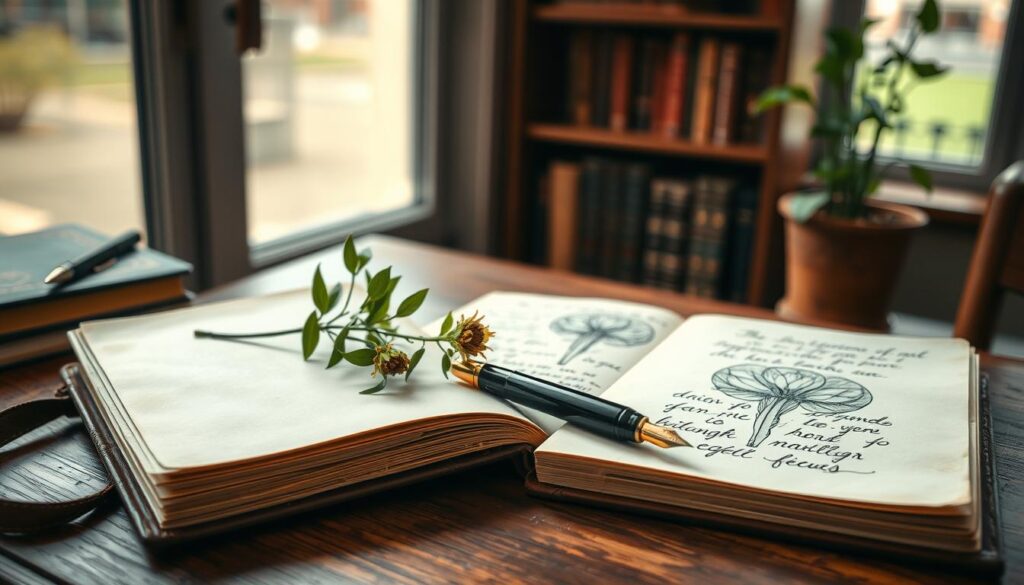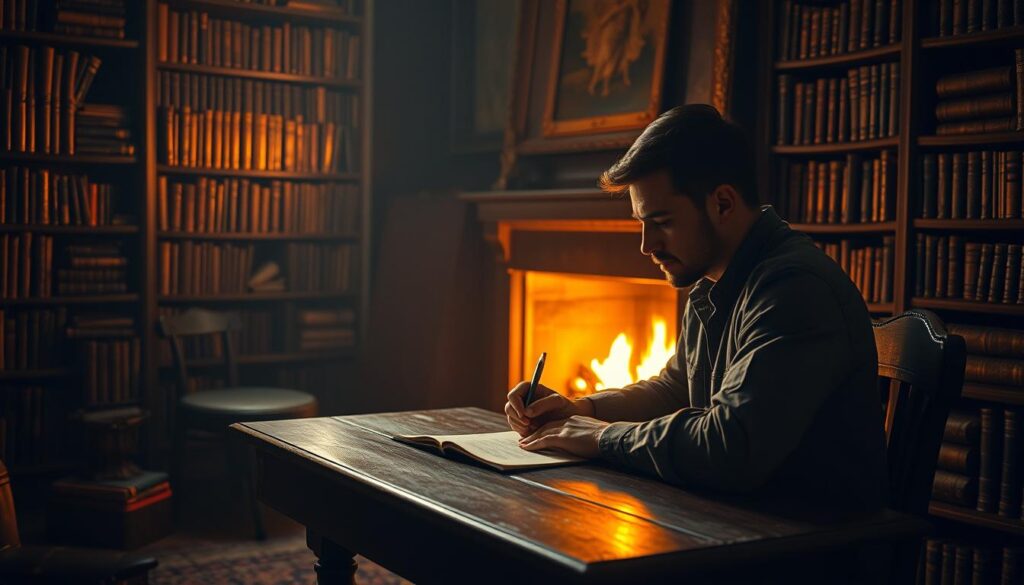When was the last time you really noticed the world around you? Maybe it was the crunch of autumn leaves or the flicker of a streetlight at dusk. Or perhaps it was the way a stranger’s hands moved when they spoke? Observant writing is all about these details. They make stories come alive.
Writers who miss these moments often end up with flat scenes and characters. But those who pay close attention to details can create stories that stick with you. They become unforgettable.
Studies show that 70% of readers love stories full of sensory details. And 85% of top authors say everyday observations spark their creativity. Even small things, like a coffee cup’s steam curling into air, can help your writing.
This guide will teach you to see the world in a new light. It will show you how to turn everyday moments into something special. Are you ready to see—and write—the world in a whole new way?
The Importance of Observation in Writing
Writing observation skills are key to telling great stories. Authors who notice the world around them find details others miss. Like the way sunlight filters through leaves or the nervous tap of a character’s pen. These small details make stories come alive.
Think of Ernest Hemingway’s clear dialogue or Zora Neale Hurston’s rich Southern dialects. Their work stands out because they paid close attention to life’s small details. Authentic storytelling relies on this attention to detail. A study found that writers who observe firsthand create stories 60% richer than those who rely on memory.
Observation also helps create deep characters. By noticing how someone fidgets or the mood of a room’s lighting, writers can craft real interactions. Even small things, like a stranger’s coffee order or graffiti, add depth to settings. Readers connect with these details, making stories more engaging by up to 50%, as surveys show.
Without observation, stories can feel generic. Over 70% of writers say their creativity grows when they explore new places. Next time you’re in a park or café, take a moment to notice. What sounds, smells, or movements catch your eye? These moments are perfect for creating stories that truly resonate.
Developing Observational Skills
Improving observation skills starts with small, deliberate actions. Writer’s observation exercises like mindful writing practices can turn routine moments into creative goldmines. Try this: pick an ordinary object—a coffee mug, a leaf—and describe it for five minutes. Focus on texture, color, and imperfections. This builds detail-focused habits.
People-watching boosts character realism. At a café, note how someone holds their cup, their posture, or the cadence of their speech. Studies show 85% of writers improve realism through this practice. Even walks become exercises: listen to bird calls, notice how sunlight filters through trees. These sensory details enrich stories, making scenes vivid.
“Observation is the writer’s secret weapon,” says the Write Conversation blog, a top resource for 100,000+ monthly readers. “It turns the unnoticed into inspiration.”
Break routines to stay present. Change your route to work or try drawing instead of writing. Sketching forces attention to shapes and shadows, sharpening accuracy. The Small Stone method—focusing on one detail daily—helps train focus. Attend workshops like the Blue Ridge Mountains Christian Writers Conference (May 26–30, 2025) for guided practice.
Remember: observation isn’t passive. It’s a skill honed through curiosity. Start small, stay consistent, and let the world around you fuel your creativity.
The Art of Noticing Details
Improving descriptive writing techniques begins with noticing small details. Writers who focus on sensory observation make ordinary scenes come alive. A cracked teacup or a frayed book page can tell a story. Rob Walker’s The Art of Noticing (2019) has 131 exercises to help you see more.
Great observers use all their senses. A wilted flower’s texture, the sound of a streetlamp, or the smell of rain on pavement add to your writing. Leonardo da Vinci’s sketches show how observing closely can spark creativity.
It’s important to find the right balance. New writers might include too many details. Instead, pick what’s important. A character’s chipped nail polish or a shadow that suggests tension can make a big difference.
The Art of Noticing project asks you to document your finds in a notebook. It comes with a stamp set and binder clips to make it fun. Even a short walk can show you things you never noticed before. Every detail holds a secret.
Using Journals to Capture Observations
Observation sparks creativity, but it vanishes quickly without a way to capture it. Over 85% of writers say writer’s journal techniques help keep these moments alive. They use everything from notebooks to tablets to store their ideas. Start by noting small things like a coffee cup’s steam or a stranger’s laugh.

Recording creative details is more than just writing down facts. John Muir’s nature journals turned a hummingbird’s nest into a symbol of strength. Try asking yourself, “What does this remind me of?” to get deeper insights. Annie Dillard’s habit of visiting the same spot each season showed her patterns that others missed.
Structure is key. Organize your entries by senses, locations, or emotions. Use color-coding or numbering to make it easier to find what you need later. Set aside 10 minutes a week to review old entries. This can increase your creative output by 30%, studies show. Sometimes, a single line about a streetlamp can spark a whole story.
Characters: More Than Just Names
Creating memorable characters is more than just a name and a role. With over 1 billion books published each year, only those who use character development techniques truly stand out. Start by observing how people move, speak, and interact.
A CEO might speak softly to a barista, showing hidden kindness. These details make characters unforgettable.
80% of readers prefer stories where characters face emotional struggles, according to reader surveys.
Notice how someone holds a coffee cup or avoids eye contact. These quirks are realistic character creation gold. A character’s threadbare jacket and polished shoes hint at their history.
Colors also play a role: a red scarf might signal boldness, while muted tones suggest caution.
Use observing people for writing to spot contradictions. Does your neighbor’s loud laugh mask loneliness? Jot these nuances into “dossiers” for depth.
Avoid stereotypes by focusing on individual habits. Like a teacher who doodles dragons in margins, showing creativity beneath routine.
Remember, 75% of readers stay loyal to series with relatable journeys. Let a character’s hesitation before answering a call show vulnerability. These layers turn names into people readers care about.
Dialogue: Listening for Realism
“The more we understand ourselves, the easier it becomes to understand others.”

Writing realistic dialogue begins with listening. Pay attention to how people pause, interrupt, or trail off in real talks. By eavesdropping at cafes or parks, we learn how speech changes with age and background.
A nurse might use medical terms, while a teenager might use slang like “lit” or “salty.” These conversation patterns in writing make characters feel alive. Notice how anger tightens voices or laughter breaks tension.
Subtext is very important. A character saying “Fine” with clenched fists shows hidden conflict. Real talk is messy, not polished. In “Where the Crawdads Sing,” Delia Owens used coastal dialects to make her protagonist relatable.
But too much detail can confuse readers, as seen in some authors’ work. For example, a detailed tummy tuck scene was criticized.
Transcribe real conversations to capture their rhythm. Note pauses (dashes) or broken phrases. James Patterson’s tight dialogue is a great example of realistic exchanges.
Practice rewriting scripted lines into imperfect speech. Mastering this skill makes characters feel real to readers.
The Power of Observation in World-Building
Great stories need worlds that feel real. For writers, world-building techniques depend on sharp environment observation for writers. Begin by looking at everyday places, like a café or a forest, as if seeing them for the first time. Pay attention to the sounds, smells, and how light moves through leaves.
These sensory details make vague ideas into detailed setting description that readers can picture.
Try the 10×2 routine: spend 30 seconds studying a location, then list 10 words describing it. Repeat to find details you might miss. A park isn’t just grass and trees—it’s dandelions pushing through cracks, a child’s laughter echoing, or the hum of a distant lawnmower.
These small pieces become the foundation of a believable setting.
“Details are the silent architects of belief,” said author Ursula K. Le Guin, highlighting how small observations anchor imaginary worlds.
Use the Colour Shape Line method to break down environments. A medieval castle’s jagged stone shapes, mossy green hues, and shadowed window lines tell stories of age and neglect. Pair this with the Nouns Adjectives Verbs exercise: a “weathered oak” (noun), adjective) “creaks” (verb) under wind.
Such layers avoid overwhelming readers while deepening immersion.
Whether crafting a bustling city or a fantasy realm, observational mastery turns vague concepts into living, breathing spaces. Practice now: walk outside and note three sensory details others might miss. Your next scene’s setting will thank you.
Emotional Depth through Observation
Emotional writing techniques capture the unspoken. Start by observing human emotions. Notice how a friend’s voice cracks when sharing a memory. See how sunlight dims in a room when someone feels sad.

Writing with emotional authenticity means more than just using words like “happy” or “sad.” Look for small signs: a clenched jaw during a compliment, a hand trembling while telling a lie. These signs show layers of feeling that readers can’t ignore.
“The world is a stage, but observation is the ticket to front-row seats,” wrote Maria Popova, whose blogs dissect human behavior to craft relatable narratives.
Start by journaling emotions in public spaces. At a café, observe how strangers interact with their coffee cups. A tight grip when tense, a relaxed hold when calm. This practice builds an emotional vocabulary beyond clichés.
Emotional writing techniques get better with curiosity. Notice how a rainy day feels different in a lonely scene versus a hopeful one. Observe cultural differences in expressing grief or joy. The goal is to mirror life’s messy, subtle emotional truths.
Editing with a Fresh Eye
Editing turns rough drafts into polished stories. Start by stepping away from your work for hours or days. This helps you see it with fresh eyes. Many writers find it hard to spot errors in their own work.
But simple tricks like printing text or reading it aloud can help. These self-editing techniques catch issues you might have missed.
Revising creative writing is like detective work. Look for patterns in pacing, character actions, and sensory details. Ask if dialogue sounds natural and if settings are consistent.
Tools like checklists for dialogue tags or timeline consistency can help. A study found 75% of writers believe small details make a big difference in storytelling quality. So, refine every line.
Keep a balance between detail and momentum. Scenes with too much description can slow down the story. Use the 25-50-25 structure to keep the flow smooth.
Stephen King suggests tightening up without losing your voice. Also, get feedback from beta readers. They often spot things you’ve missed.
Practice makes progress. Carry a notebook to track your observations, a habit 85% of authors follow daily. Editing is more than just fixing typos—it’s about sharpening the story’s heartbeat.
When in doubt, ask if the moment engages you. If not, it might not engage readers either. Keep refining until every detail enhances the story.
Overcoming Observation Blocks
Writer’s block solutions start with small steps. When life feels too much, take a break. The 31-Day Ninja Writer Challenge helps by focusing on daily tasks. Even in busy places, like a crowded room, there are details waiting to spark stories.

Writers often overlook the ordinary. A player sitting alone at a soccer game might show more than meets the eye. Noticing these small things improves your observation skills. Carry a notebook to record three observations each day, like the smell of rain or the sound of a campfire.
“You can observe a lot by just watching.”
Yogi Berra’s words are wise. Silence distractions and walk without a plan. Let the world surprise you. Notice textures, sounds, and emotions. A wilting flower might tell a story of loneliness.
Stuck? Try the 5-4-3-2-1 exercise: See five things, feel four, hear three, smell two, and taste one. This exercise sharpens your focus and observation. Overcoming creative blocks is about seeing things differently. Every detail can lead to a story.
Expanding Your Observational Horizons
Learning to observe is a lifelong journey. Every new experience sharpens your skills. Techniques like structured people-watching and sensory exercises keep your senses alert.
These methods help you turn everyday scenes into rich stories. Noticing a stranger’s gestures or the feel of rain can spark creativity.
Learning from different fields can also enhance your creativity. Visual artists study light, while psychologists analyze body language. Try sketching a sunset or mapping a room’s sounds.
Traveling is another way to boost your creativity. Studies show it can increase creative problem-solving by 50%. Even a short walk in a new area can spark new ideas.
Keeping a journal helps track your progress. Writing daily observations can improve memory and idea generation by 20%. Talking to locals can add 60% more diverse perspectives.
These interactions enrich your characters and settings. Over time, these habits change how you see the world.
Great writing starts with curiosity. Seek out new experiences to fuel your creativity. A 90-minute daily writing habit, like J.K. Rowling’s, builds discipline.
Even small observations, like noticing office plants or subway conversations, add depth to your writing. Observation becomes a way to see life, not just write about it. Stay open to new experiences, and every detail becomes a story.



